Video is a powerful tool for marketers. While social networks like Facebook and Instagram are working to become better video platforms, YouTube remains the best place to create and promote video content.
In this beginner’s guide to YouTube marketing, you’ll learn how to create a YouTube marketing strategy from start to finish.
What is YouTube Marketing?
YouTube marketing is the process of promoting a business through a YouTube channel. It can involve publishing videos to rank in YouTube search results, running different types of YouTube ads, or even promoting your channel through other mediums like Google Search.
Why Is YouTube Marketing Important?
YouTube marketing is important for today’s business because of the platform’s massive reach.
YouTube receives over 2 billion monthly visitors, and these viewers watch over 1 billion hours of videos every month.
With these numbers, YouTube offers unparalleled reach for businesses looking to connect with their target audience.
You may think that much of YouTube’s viewership is mindless consumption, but this is not true.
According to YouTube, 68% of users have watched YouTube videos to help decide what to buy.
As such, businesses that can get viewers to their videos have an excellent opportunity to turn these people into customers.
The fastest way to understand how YouTube marketing works is to follow a proven step-by-step blueprint. The YouTube Marketing Course will teach you how to create a YouTube strategy from scratch to increase your subscribers and sales on YouTube as fast as possible. It is perfect for beginners with no prior experience.
How To Get Started With YouTube Marketing
Follow these steps to create a winning marketing strategy on YouTube.
- Create a YouTube Channel
- Research Your Competitors
- Plan Out Your Video Strategy
- Find Keywords for Your Videos
- Produce High-Quality Videos
- Become an Expert on YouTube SEO
- Master YouTube Advertising
- Promote Your Videos With Blogging
- Analyze YouTube Analytics
- Partner with YouTube Influencers
1. Create a YouTube Channel
The first step in YouTube marketing is to create a YouTube Channel. Your channel is like any other social media profile. It is where you will post your content, grow your following, and engage with your audience.
YouTube has two types of channels: personal and brand (business). With a personal channel, your YouTube profile will use the same name and profile image as your Google account.
On the other hand, brand channels are tied to a business rather than a specific person. I recommend creating a brand channel, even if you plan on using your name for the channel.
After you create your channel, you’ll want to begin prepping it for YouTube marketing. Here are some ways to do so.
Add channel description

Your channel description appears on the About tab of your YouTube channel. It is where viewers go to learn about your channel and the types of content you create.
You’ll want to add the most important information about your channel to this description.
Channel descriptions also appear in YouTube search results. Here, the description is truncated, so you should look to state your key details in the first 150 characters.
Choose channel icon
Your channel icon is another important part of your channel. This little profile image is shown everywhere across YouTube, including your home page, beneath your videos, and in search results.
You’ll want to fill the icon with a quality image that aligns with the nature of your channel.
Add channel art

Your channel art is a banner image on the top of your channel page. This area of the page is great for capturing visitors’ attention.
You should use the banner to showcase a brand-aligned image or to convey more information about your channel.
2. Research Your Competitors
By analyzing competitors, you can quickly see what works well while understanding what your audience is after. Plus, it gives you easy inspiration for topics to cover in your videos.
Checking competitor channels directly
There are several ways to perform competitive research for YouTube. The simplest method is to visit a competitor's channel and review it directly from YouTube.
When on a competitor’s channel, start by looking at the number of subscribers. This will give you an idea of the channel’s popularity and whether it is a leader in the niche.
You then want to dig into the stats for individual videos. Check to see which videos get the most views and likes. This will clearly indicate what types of content are popular and what viewers find interesting.
To do this, click the VIDEOS tab and select MOST POPULAR from the SORT BY dropdown list.
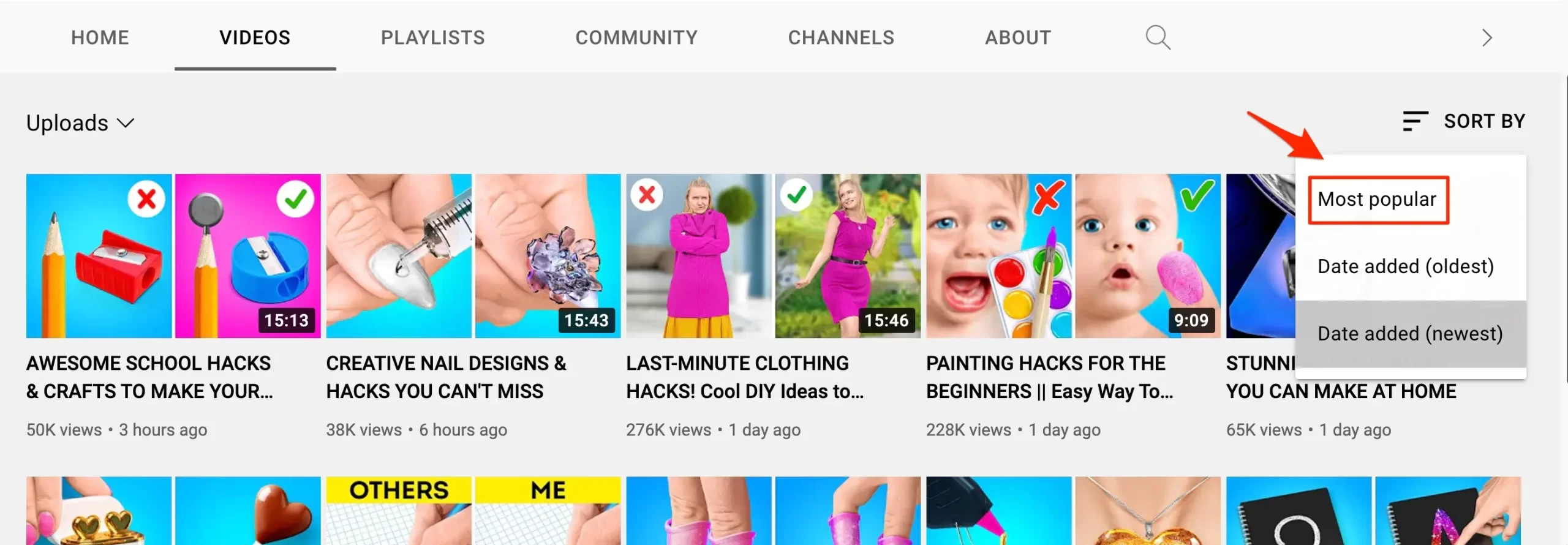
If you want to better understand how the channel connects with its audience, check out the video comments. There, you can see exactly what viewers think and even how the brand is engaging with the audience through their responses.
I also recommend subscribing to the channels of your top competitors. By subscribing, you’ll get notifications when they add new videos to gain insight into their posting schedule.
Checking competitors with YouTube research tools
Another way to analyze the competition is to use a YouTube research tool. With a tool like vidIQ, you can add your main competitors to your account to track their views, subscriber growth, and other metrics.
3. Plan Out Your Video Strategy
Once you’ve analyzed the competition, it’s time to plan your video marketing strategy. You want to clearly understand how video can help you reach your marketing objectives.
Start by defining the main goal for your channel and what success looks like.
- Are you aiming to increase brand exposure?
- Generate new sales?
- Get more subscribers?
By clearly setting a goal for your channel, you’ll ensure all your marketing efforts are best suited to reach your desired results.
Audience profiling
After you determine the goal for your channel, you want to profile your audience. This is the process of defining the key traits of your ideal customer. With this information, you’ll know who to target with your videos.
Some of the elements to analyze include:
- Demographics: This includes traits like age, gender, and income.
- Psychographics: This includes the traits that show your audience's interests and behavior, such as their lifestyle, values, interests, and personalities.
- Online behavior: Where your audience hangs out online and what content they consume.
The ideal strategy will usually include a mix of different types of content. This could include how-to and tutorial videos, product reviews, listicle videos, or Q&A videos.
Traffic type
When creating a YouTube video strategy, you’ll also need to decide which types of traffic to pursue.
There is organic traffic. This comes from people who land on your channel after finding one of your videos in the search results.
Then there is paid traffic. This comes from running YouTube ads that bring people to your channel.
Both sources have their benefits and are generally combined in a marketing strategy.
Organic traffic allows you to reach highly targeted visitors at scale and without cost. You just may need to wait for a little to see the results.
A YouTube ad is generally less impactful than a video directly related to what someone is looking for. But they can help you get in front of viewers immediately without having to rank high in search results.
4. Find Keywords for Your Videos
The next step is to find the best keywords for your videos. These are the search terms that customers use to find content on YouTube.
The process of uncovering these keywords is called YouTube keyword research. It is an essential first step in optimizing your channel for YouTube SEO.
When you know the best keywords to target, you can quickly embed them throughout your channel to ensure that your videos appear at the top of results for relevant searches.
Here are some of the best ways to find keywords for your videos.
YouTube Autocomplete

The simplest way to find keywords is to use YouTube itself. When you start to type in the YouTube search field, the autocomplete feature will populate suggestions based on the letters you’re typing.
For example, if you type the word how, the search field will pull a list of suggestions like “how to tie a tie”, “how to wing foil”, and “how to draw”.
YouTube shows the most popular terms in the autocomplete feature, making it a quick way to find keywords with good traffic potential.
Check Competitors
Competitor analysis is another effective way to find keywords.
Go to a competitor’s channel and find their most popular videos. Look to see what phrases are prominently featured. You’ll want to check video titles, descriptions, and tags, as these are the important SEO areas where competitors will include their keywords.
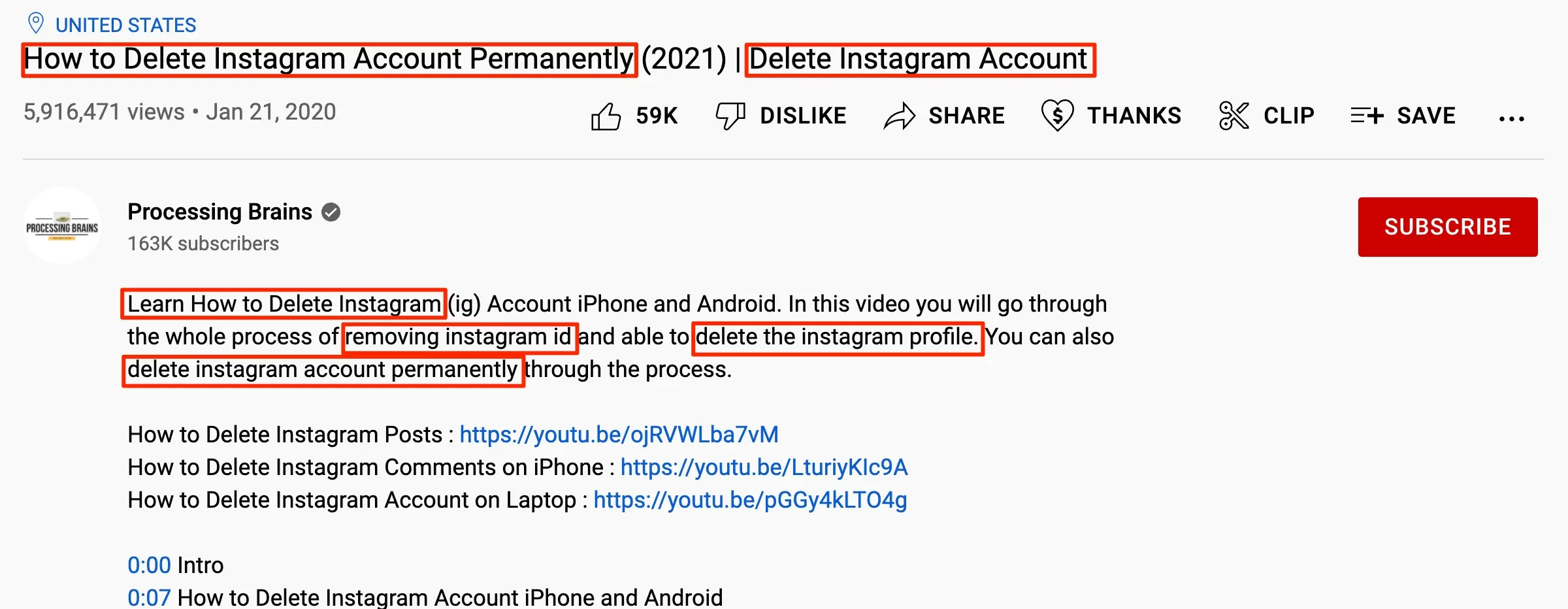
YouTube Keyword Research Tools
YouTube Keyword research tools are the most robust way to look for keywords. These solutions have a database of YouTube keywords that you can search to discover new terms.
In addition to providing the keywords, many YouTube keyword research tools include essential data such as monthly search volume and how the keyword is trending over time.
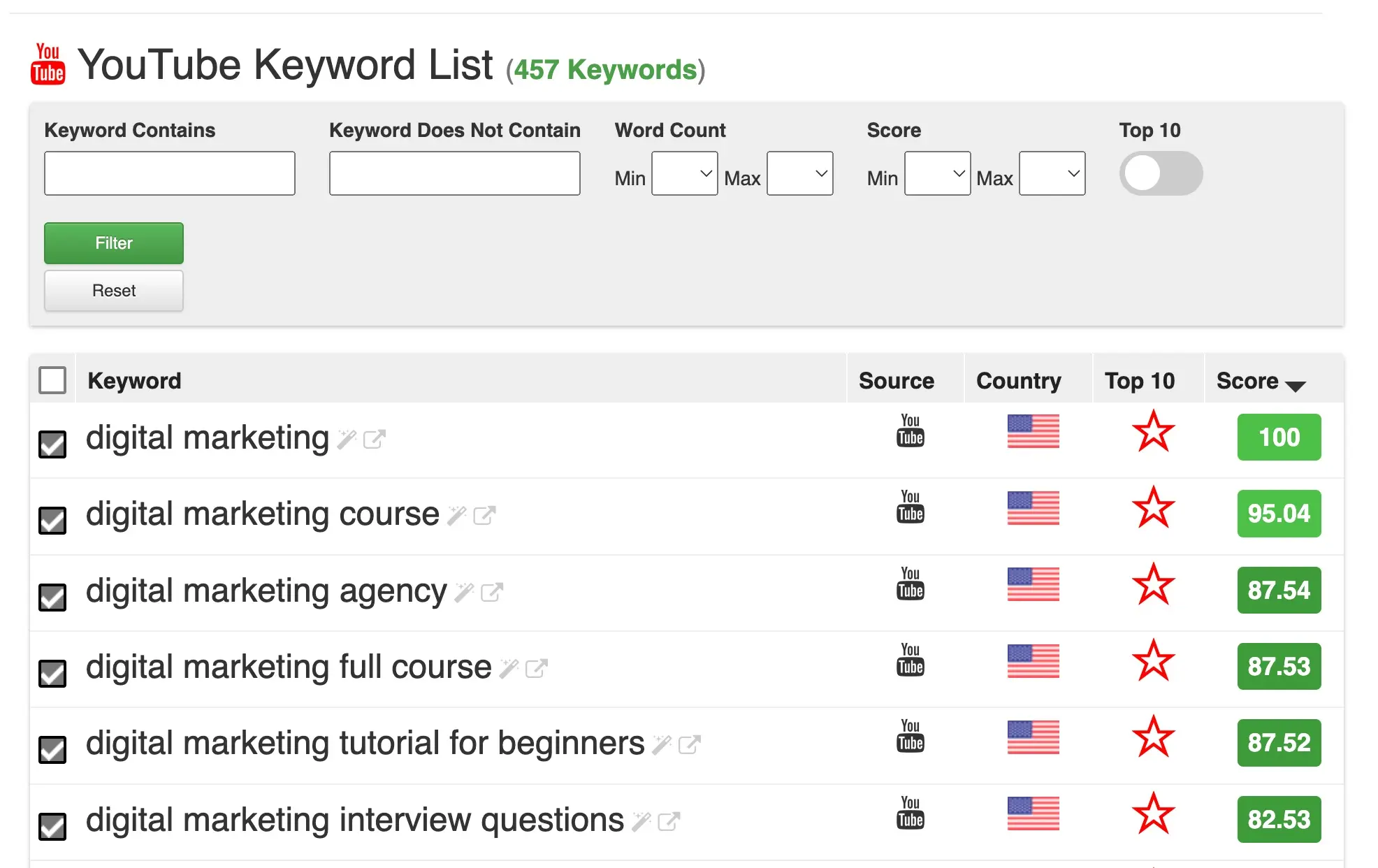
5. Produce High-Quality Videos
To succeed with YouTube video marketing, your videos must be high quality.
Viewers have high expectations when it comes to video content. They may not expect to see movie-level production with every video, but they expect to find crisp sound and a clear picture.
Production quality isn’t the only factor in a high-quality video. You also want to create videos that people enjoy. This means that your videos should be engaging and hold the audience’s interest.
You want people to feel that they gained something from watching your content and that checking out your channel in the future would be worthwhile.
So, how do you get people to like your videos? It starts with the content itself. You should provide the information the viewer seeks while presenting it in an engaging manner.
In addition, YouTube has several features to improve the viewing experience, such as timestamps and playlists.
Timestamps divide your video into chapters, making it easier for viewers to skip to the parts they’re most interested in. When people can find the specific moments they’re looking for, they’ll spend more time watching your videos.
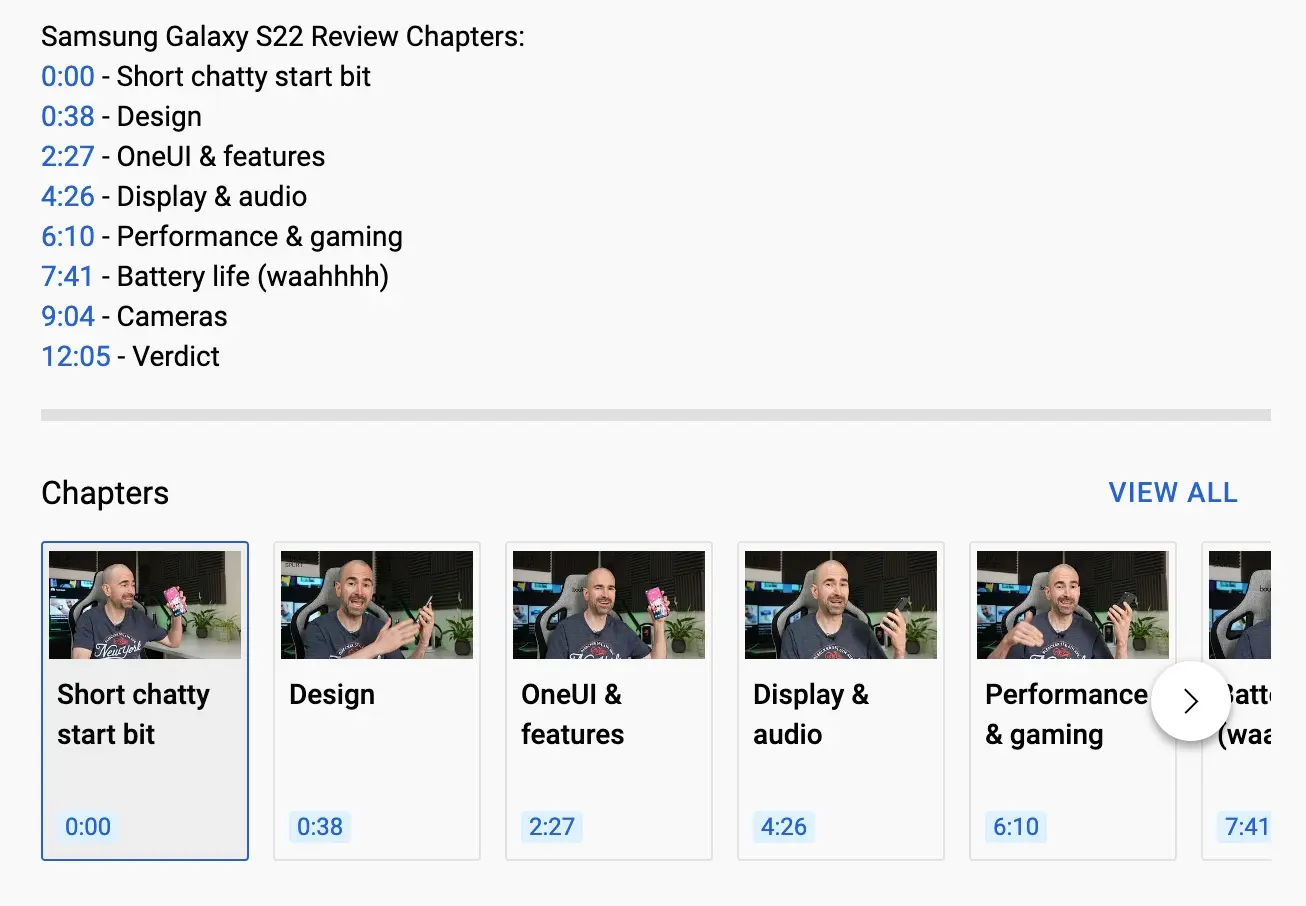
With a playlist, you can organize your videos into clearly defined topics. This enables viewers to find and watch content in a specific area effortlessly.
There are several metrics that you can use to track how well your audience is liking your videos:
Watch time
Watch time measures the total amount of time people spend watching your videos. In most cases, high watch time is one of the best signs of a high-quality video.
You can have a lot of views, but if the watch time is low, it’s a sign that people are leaving your video quickly and that it may be of poor quality.
Average view duration
Average view duration measures the average amount of time each viewer spends watching a video. Like watch time, this metric clearly indicates how well people are enjoying your content. High average view durations generally mean a high-quality video.
Audience retention
Audience retention shows how many of your viewers engage with your channel repeatedly. Getting people to come back to your channel again and again is a good sign that they like your videos.
6. Become an Expert on YouTube SEO
YouTube marketing would not be complete without YouTube SEO (search engine optimization).
YouTube is the second-biggest search engine in the world. Many users rely on its search feature to find the content they’re interested in.
With YouTube SEO, you can tailor your videos and channel to appear in front of your audience for these searches.
The foundation of any YouTube SEO strategy is keyword research, which we’ve previously discussed. You need to know the keywords to target for your videos to rank.
Once you find your keywords, there are several key places to add them:
Video titles
Video titles are an important SEO factor and an essential place to include your main keywords. Titles help viewers know what a video is about. So, YouTube will factor them heavily when determining rankings.
Video descriptions
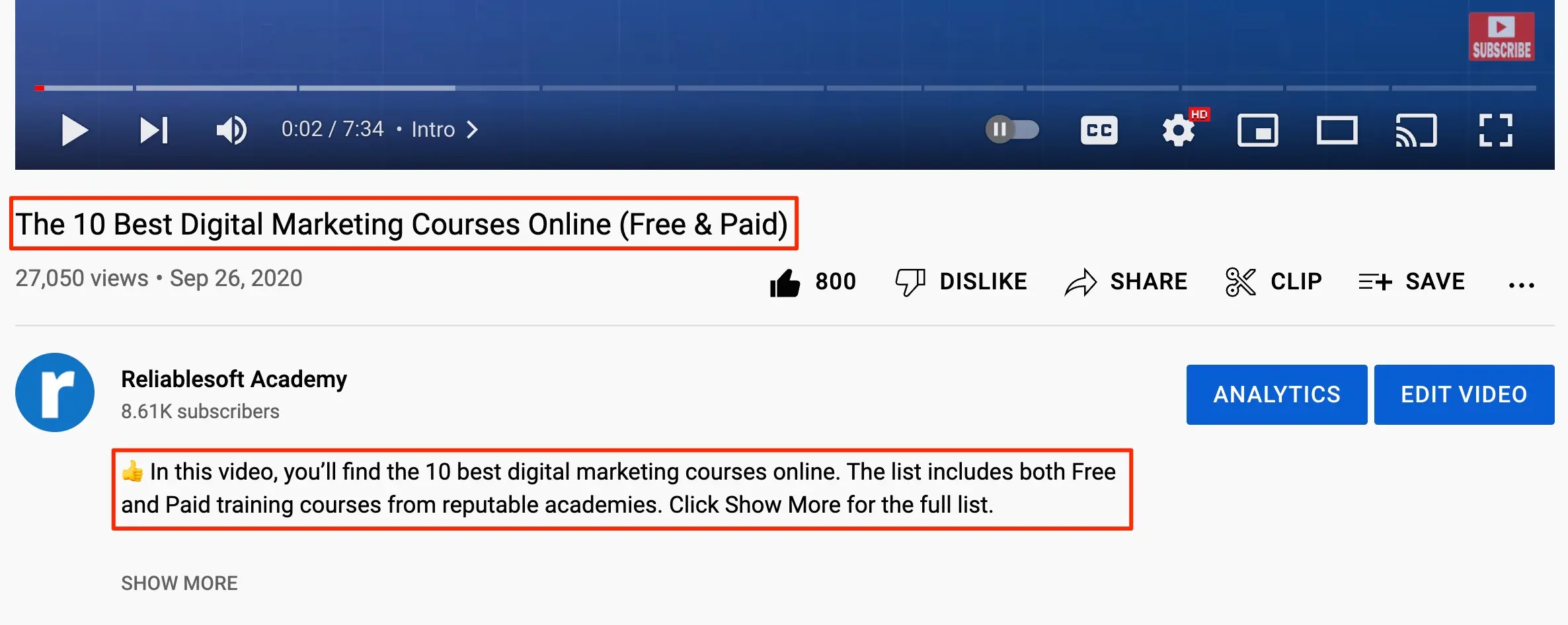
Like titles, video descriptions help viewers understand your content. You want to include your main keywords at the beginning of your descriptions. Doing so will signal to YouTube that your content is related to the target term.
Tags
Tags are another descriptive element that helps viewers understand your videos. They also help YouTube understand your videos, so you should include your target keywords in these tags.
Other YouTube SEO factors
Beyond keywords, there are various other big YouTube SEO ranking factors. Many of these are centered around video quality and user experience. YouTube wants to surface videos that meet viewers' expectations.
For instance, watch time is an important SEO signal, showing viewers find your content relevant and enjoyable.
View count is another key factor. High view counts increase the chances YouTube will rank the video at the top of the results.
Some other important ranking factors include
- Click-through rates (CTR): How many people click your videos after seeing the thumbnail
- Comments: how many people are engaging with your videos by leaving comments
- Likes: How many people hit the “thumbs up” button to like your videos
7. Master YouTube Advertising
YouTube is a great platform for search traffic and an effective place to advertise your business.
It has a massive audience and a wide variety of ad formats and targeting options to ensure your ads reach the right people.
Below are the most popular types of YouTube ads:
Skippable in-stream video ads

These ads appear before or during videos on YouTube. Viewers have the option to skip the ad after the first 5 seconds. However, you only need to pay for the ad when some watches over seconds or clicks the ad.
In-stream ads can range from 12 seconds long to minutes in duration. They are effective for getting in front of people unfamiliar with your business.
Non-skippable in-stream video ads
These ads are another form of in-stream advertisement. The key difference is that viewers cannot skip them.
Non-skippable ads are a great option to guarantee that a certain number of people see your ads.
Discovery ads
Discovery ads work similarly to search ads in Google. With a discovery campaign, your ads appear in the organic search results. They include a thumbnail and three lines of text.
Anyone who clicks your ad is taken to your channel or a specific video.
Non-video ads
YouTube also offers several non-video advertisement formats. These include display ads that appear in the right-hand sidebar and in-video overlay ads that appear on top of video content.
Non-video ads are useful tools for those looking to take advantage of YouTube’s audience without spending the time and money to create a video.
Creating YouTube ad campaigns
Creating campaigns for your YouTube ads is a straightforward process.
You’ll start by selecting a campaign goal. This could be sales, leads, web traffic, or brand awareness.
You then need to select your ad type and other campaign parameters, such as your audience, bid, and budget strategy.
8. Promote Your Videos With Blogging
YouTube marketing isn’t restricted to YouTube. Successful YouTube marketers know how to leverage other platforms to attract people to their channel and promote their businesses.
Google, in particular, can be an incredibly valuable source of traffic. One of the best ways to get more exposure from Google is to publish SEO-optimized posts on your blog and then embed your YouTube videos on the page.
With a blog, you can reach a new group that may not use YouTube. By targeting people on both platforms, you can grow your business faster.
Plus, videos are a great way to make your blog posts more exciting.
Now, some types of posts will work better with videos than others. For example, how-to-type posts are a perfect fit for adding a corresponding tutorial.
You can even repurpose the transcript from the video to make creating the blog content easier.
Naturally, many people watching your blog's videos will click through to your YouTube channel.
You can increase engagement even more by adding a subscribe to YouTube button to your blog. This will allow people to instantly subscribe to your YouTube channel directly from your blog.
9. Analyze YouTube Analytics
As you ramp up your YouTube marketing, you must monitor your results to see if your strategy works.
YouTube's robust analytics platform makes this easy. It includes all the metrics and key performance indicators (KPI) needed to evaluate your channel’s success.
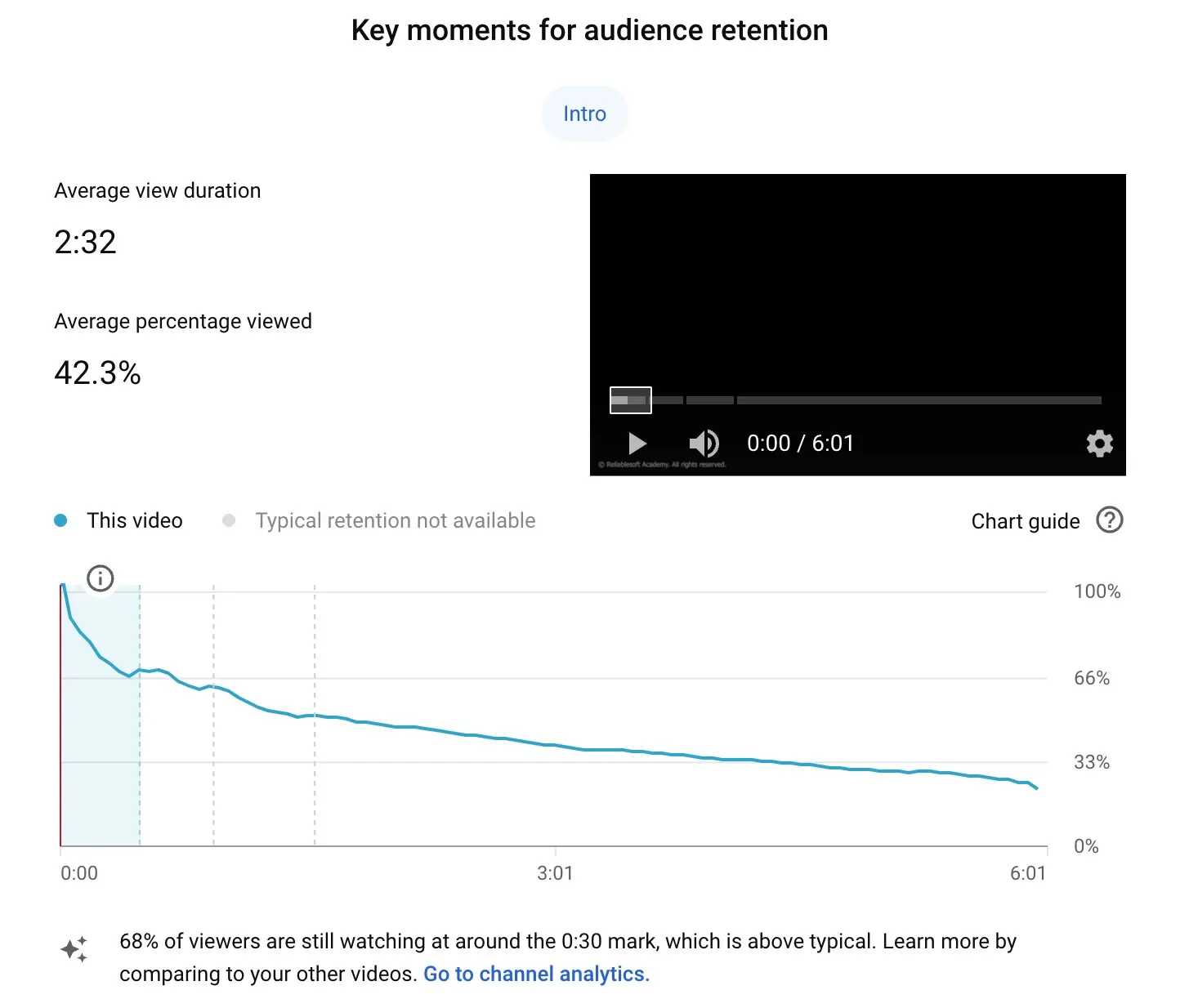
Here are some of the important YouTube metrics to keep your eye on.
Subscribers
The number of people that have subscribed to your channel. This metric shows your channel’s popularity and how well your videos resonate with your audience.
Channel views
Channel views show the total number of views your video received over a certain time period. This metric also helps you see your channel’s popularity.
Channel watch time
This metric shows the total time people watch your channel’s videos over a given period. It can help you see if people are liking your videos.
Top videos
This metric shows which of your videos had the most views over a given period. You can use these insights to know what types of content to prioritize.
Average view duration
The average amount of time viewers spend watching your videos is another metric showing whether people like your videos.
Top YouTube search terms
This is a list of the keywords that lead people to your videos. It can help you see where you’re having the best success with YouTube SEO.
Click-through rate (CTR)
The percentage of people that click on a thumbnail to view your videos. A high CTR is a sign that you have good keyword targeting and that your thumbnails are good at capturing attention.
These metrics show your channel's overall performance. YouTube Analytics also shows metrics for individual videos. Among these are the number of views, watch time, and average view duration.
10. Partner with YouTube Influencers
The final step in our beginner YouTube marketing guide is to partner with YouTube influencers. These are individuals who have built a large following around a specific topic.
By partnering with an influencer, you can increase exposure for your channel by getting in front of its audience. It is an effective way to help your channel grow faster and get more subscribers.
Additionally, traffic from an influencer can be highly valuable. Influencers have a strong connection with their audience, and many of their followers will be more receptive to your business, having heard of you through their favored influencer.
The key to influencer marketing with YouTube is to find the right partners. Finding good partners is usually not too difficult. However, convincing someone to market your business isn’t always guaranteed.
One of the most common methods of encouraging influencers to partner with you is to offer compensation. This can be in the form of gifts, discounts, or direct payments.
The best arrangement will depend on what you want to get out of the partnership and how extensively the influencer will promote your product.
For example, if you sponsor their video by giving them a direct payment, you should expect them to take a few minutes to talk about your business in their video content. Ideally, this occurs at the beginning of the video when viewers are more attentive.
On the other hand, you could have the influencer briefly mention your business in exchange for a free gift instead of a more substantive payment.
Conclusion
This guide has shown you the best tactics for creating a YouTube marketing strategy. The steps above will help you successfully promote your YouTube channel and grow your viewership and subscribers.



